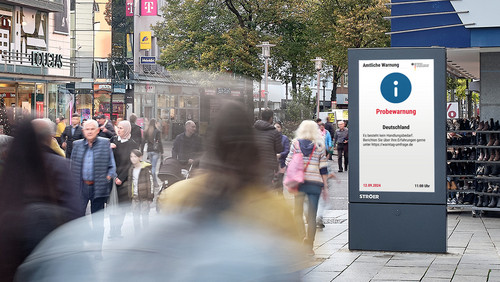
05. September 2024
Nationwide Warning Day: SHORT INTERVIEW with the BBK President Ralph Tiesler
This year's nationwide warning day will once again take place on 12 September from 11 a.m. as a test of the national warning infrastructure. Ströer's digital city information systems have been integrated into the federal government's satellite-based Modular Warning System (MoWaS) since 2018. In over 300 cities in Germany, they now act as an official channel for disseminating warnings at traffic junctions and in city centres. In our latest short interview with BBK President Ralph Tiesler, you can find out more about the warning day and why the city information systems are an important addition to the BBK's warning system.
Another Nationwide Warning Day will take place on 12 September. What expectations do you have for this year’s Warning Day?
Ralph Tiesler: In view of the very good results from 2023, I’m looking ahead to Nationwide Warning Day 2024 with confidence and hope that we can achieve good results again. But that doesn’t mean we can sit back and relax. The Warning Day is deliberately designed as a stress test to see whether we’ve been able to eliminate potential weaknesses identified in the past and thoroughly test the warning systems that run smoothly on a day-to-day basis.
Since 2018, Ströer’s digital city information systems have been connected to the federal government’s central Modular Warning System (MoWaS). This means that over 6,000 screens in Germany can now display warning messages. Why are city information systems an important addition to the BBK’s mix of warning devices and how can they provide support in an emergency?
Ralph Tiesler: Each warning device has its specific advantages and disadvantages. While warning devices such as sirens or cell broadcasts have more of a wake-up effect, i.e. alert citizens to an immediate danger, other warning devices such as warning apps offer more space for detailed information. The city information systems excel in that they can warn citizens quickly and reliably in their everyday lives in urban areas as well as displaying specific recommendations for action in addition to the hazard message, thus perfectly complementing the existing mix of warning devices.
What are the BBK’s most important goals in terms of warning the population in the coming years? Is the BBK planning further measures/actions to inform the public via the various warning channels, including the digital city information systems?
Ralph Tiesler: The Federal Office of Civil Protection and Disaster Assistance (BBK) is closely monitoring innovations in the field of warning devices. The challenge here is to distinguish short-term trends from long-term developments. To further expand the warning systems accordingly and to supplement the existing warning devices in a targeted manner, we also rely on feedback from citizens. As in the previous year, we are therefore once again conducting an online survey in which we ask the public to share their experiences of Nationwide Warning Day with us and tell us whether and which warning devices have reached them. We would again be delighted if many people took part. The survey will be activated directly on the Warning Day at 11:00 a.m. at “www.Warnung-Umfrage.de” and will run for one week.

Ralph Tiesler has been President of the Federal Office of Civil Protection and Disaster Assistance (BBK) since 15 June 2022. The lawyer has been working in the federal service for 30 years, 24 of them in civil protection.
The Nationwide Warning Day is a joint day of action organised by the federal government, federal states and local authorities. It takes place annually on the second Thursday in September. In 2024, this will be 12 September. A test warning is sent out from 11 am. The all-clear is given at around 11.45 am. The Nationwide Warning Day serves to test the warning systems. However, the triggering of the warning devices also serves as an opportunity to inform the population about the warning.


